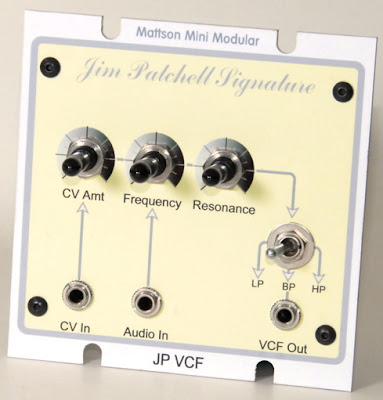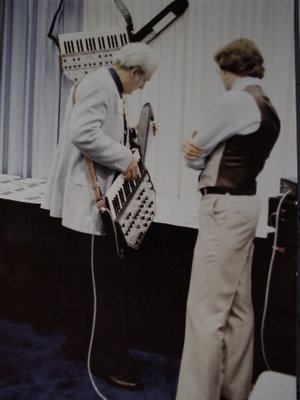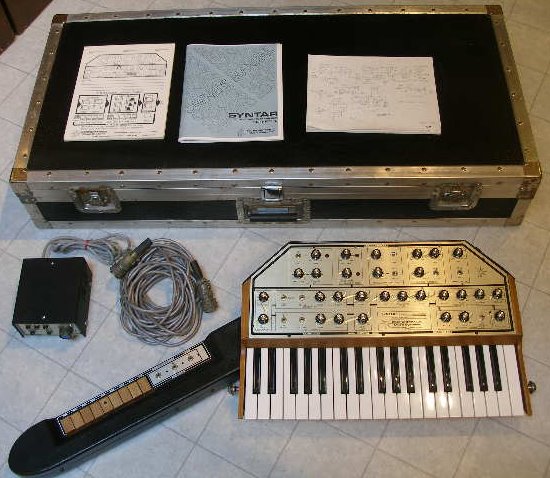In case you missed it,
click here for a letter from George Mattson on the MMM Phoenix series analog modular synth. I thought I'd pull some highlights from the letter below, but please do read the full letter. You can also find a detailed spec list for each module available for the system
here, and you can find more info on the Syntar
here and
here.

"My name is George Mattson.
30 years ago I developed and manufactured a performance oriented analog synthesizer I called a Syntar. The synthesizer was innovative at the time, met with limited success and has recently become a topic of conversation in a variety of synthesizer forums.

Due to the growing abundance of new, analog synthesizer enthusiasts, I have been asked to return to manufacturing.
I took the core circuits of the Syntar (thus, the Phoenix Series) and designed a new format; a portable, true analog modular synthesizer specifically budgeted for the new market."
[Matrix: note the analog of the Phoenix rising out of the ashes of the Syntar.]
Some highlights on some unique modules to the system.

"Signal distribution: I do have one major design philosophy quirk. I don’t like passive multiples-period. Using a passive multiple for signal distribution degrades the signal. Using a passive multiple as a “mixer” sums the signals together and can lead to overloading the input of the destination module. I designed two new modules to replace these functions:
The 4X-1X2 buffer: Sort of a buffered “splitter”. It can take 4 different input signals and split them into two output signals for each channel. Each signal is buffered so, the signal is rejuvenated and doesn’t degrade. I took the liberty of cascading the channel outputs into the input of the next channel. So, if a signal is patched into channel 1, it is available on all 8 outputs until the chain is broken with a subsequent channel input. Then, the original signal is available on the preceding outputs while the new signal is available on all of the remaining outputs. It sounds weird but, once you’ve used it, you wonder how you were able to get by without it.
The 4X Mixer: The “other function” replacement of a passive multiple. The mixer has four inputs and actually two outputs, an inverting and a non-inverting output. I designed the mixer to be used for either audio or control voltage signals. This allows for precise adjustment of an audio mix or, a real nifty way to build complex control voltages by using multiple CV sources. In order to add a bit of excitement, my audio mixing days came back to me and I added a “punch-in” pushbutton on each channel to allow for an abrupt addition or elimination of the channel signal into or out of the mix. This is usually a subliminal function but, makes a big difference in audio or CV real-time control.

Filter: The Syntar utilized the SSM 2040 filter. They’re not available anymore at any kind of reasonable price or in guaranteed quantity. Since I had plenty to do with the rest of the system, I was able to get a custom filter designed specifically for this system kindly and graciously by Synth DIY guru Jim Patchell. He designed a 4-Pole 24dB/Octave state-variable multi-mode filter for this. That’s synth-speak for WOW. It sounds great. Thanks Jim. Way to kick a--!

Keyboard control: OK, I had to make some concessions here. Rather than designing an analog keyboard input module and trying to find and stock keyboards (they’re hard to find anymore in small quantities), I went digital and provided a MIDI-CV input module. It’s actually integrated into the power supply module, which makes this a double-wide module and isn’t available as a stand-alone module. I originally designed the system using a commercially-available MIDI-CV controller but, it had limited function, the manufacturer was hard to communicate with and they didn’t want to give me any reasonable OEM pricing. Sooooooo, I had a MIDI-CV controller designed to my specifications by Scott Rise of Division 6. This turned into one of the coolest modules. (even if it is d*g*tal) Read the module descriptions for a full description. This allows the owner to use any MIDI generating keyboard they desire, or any MIDI generating sequencer control. Mmmm- 16 systems, each utilizing a different MIDI channel. Yes, it blows the “Basic and inexpensive” philosophy out the door. But, it was actually less expensive to design and manufacture than pay the “not-so-OEM” pricing offer’s I was quoted for something less versatile. We all win. I’m negotiating with Scott (a nicer way of saying “convincing”) to produce versions of this in other formats or stand-alone units and allow me to offer them for sale on the web site." [Read
this thread for more]. via Scott in that thread: "The rumors are true; I will be coming out with a standalone version of the MIDI-CV converter. As far as an exact time frame, I'm not entirely sure yet. I need to get through the MMM launch stuff first.
I also want to get some input from people like you who might possibly have a need for such a converter or are already using one. What would you like to see it do? Now is your chance to help shape it and make it useful. The initial version is going to be based on the one I designed for the MMM but some things will need to be different. For example, should the mod wheel continue to drive a separate 0-5v output or should it modulate the main CV? Does it need an S-Trig output?
Later down the road I will be making a multi-out version that has even more features, so even if your suggestions don't make it in this version they would probably make it into the next one."
click here for the full letter.
click here for the modules.
click here for the main site.
And don't miss
the forums.































































